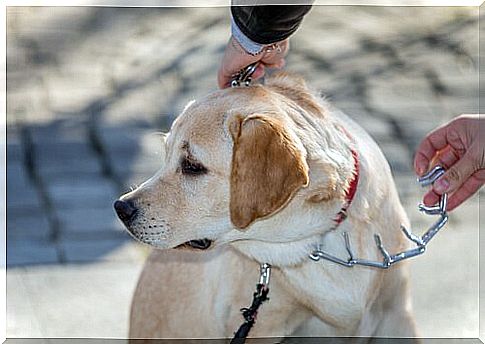Behavior Problems Caused By Penalty Collars In Dogs

Spiked, choke, and electric collars have long been used to correct behavioral problems in dogs. Over time, however, it has been found that new behavior problems arise with dog punishment collars.
What are penalty collars?
Criminal collars are also called “training collars”. These are devices that are attached to the dog’s neck and that give him a negative impulse if he does not behave properly.
Electric collars, for example, generate a vibration or an electric shock that is triggered when the dog owner presses a button on the remote control.
There are also those who activate themselves when they perceive a vibration in the neck because the dog wants to bark.
Spiked collars have spikes made of metal or plastic that dig into the dog’s neck when the dog pulls or tears on the leash to improve its behavior.
Choke collars, on the other hand , tighten around the dog’s neck.
These collars were used in dog training for a long time. For a while it was thought that they would be effective and that the dogs would learn to behave better in the process.
Now it turns out, however, that not only are they useless, but that new behavior problems are created by punishment collars .

There are still many dog trainers out there today that use these collars. In many countries around the world, however, they are already prohibited by law.
Why do people use these collars on dogs?
There are many reasons that lead a dog owner to use a penalty collar. Sometimes a dog training layman advises them to do so, such as a neighbor who has large dogs or an unscrupulous veterinarian who wants to sell something.
Dogs usually wear a penalty collar if they have behavioral problems that are of concern to their owner. They pull on the leash, are aggressive, or appear too energetic on the street.
However, penalty collars do not provide a real solution to behavioral problems ; at best, they only mask the real problem. The dog learns to control himself so that he is not exposed to the pain of the collars.
However, that doesn’t solve the problem, it just hides it. As soon as the dog’s collar is removed or the dog’s discomfort increases, the behavior that worried the owner returns.
To solve behavior problems, you have to attack them at their roots. A collar is never the solution.
Behavior problems from penalty collars
Penalty collars not only offer no solution, but also aggravate behavioral problems and also create new ones.

When a dog has behavior problems it usually means that there is a problem in the dog’s everyday life. For example, it can be stress, fear, or pain.
Dogs that bark a lot are often stressed. A collar that electrocutes them does not relieve the stress. It just prevents the barking. The problem that triggers the barking persists, however.
You don’t solve a problem by covering it up, it’s just a temporary patch. If the dog is suffering and you cannot find out what is causing the condition, then the symptoms will just show up in a different way. Instead of barking, the dog may now destroy objects in the house.
Negative conditioning of the dog
If you constantly bring pain to a dog, this also leads to new behavior problems. This is entirely in accordance with the rules of behavior and classic Pavlov conditioning.
For example, a dog owner puts a spiked collar on his dog to stop him pulling on the leash. However, the dog feels pain and discomfort while walking on the street: when a bicycle passes by, when another dog wants to greet him, when there is noise and he is frightened, etc.
The dog’s subconscious begins to associate this pain with the situations. Soon he believes that every time an unfamiliar dog approaches him, he will feel pain.
He will then do all he can to remove himself so that the collar does not puncture.
With this simple learning mechanism, the dog begins to behave aggressively towards other dogs, children, bicycles or even the garbage truck.
You cannot exactly predict which connections will be linked in your brain.

Anxiety and stress are very common emotions in dogs with punishment collars.
However, almost all behavioral problems that bothers us in dogs arise from these two feelings. These include aggressiveness, constant barking, tugging on the leash, bad relationships with other dogs, destruction of objects in the house, etc.
Alternatives to the penalty collar
Fortunately, animal psychology and education have evolved over the past few decades.
Well-trained dog trainers and loving dog owners now have much more choices in ways to solve behavioral problems in dogs without resorting to pain and fear.
The only way to solve these problems is to tackle them at their roots. In this way you make life easier for yourself and your dog for a long time and do not resort to temporary veils.
Studies have shown that dogs with a penalty collar are 55% more stressed than others. This type of collar creates fear and all of the behavior problems associated with it.









